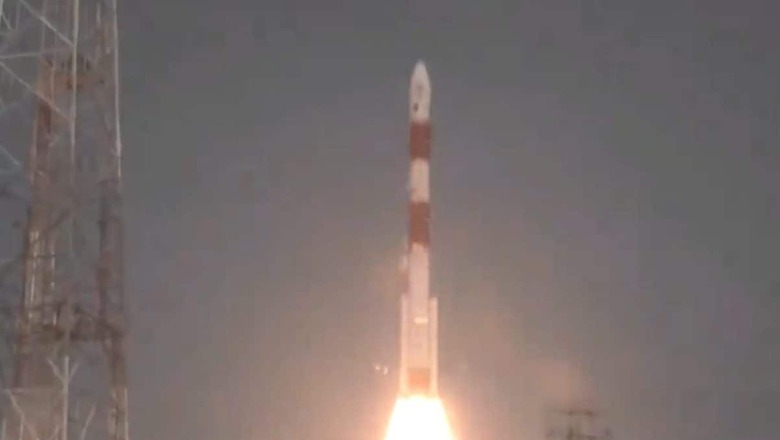
views
The Indian Space Research Organisation launched its 60th workhorse, the Polar Satellite Launch Vehicle — PSLV-C58 — on Monday from Sriharikota’s Satish Dhawan Space Centre in Andhra Pradesh.
The launch of the X-Ray Polarimeter Satellite (XPoSat) took place at 9:10 am from the Sriharikota launch pad. The mission carries primary payload XPoSat and ten other satellites to be deployed in low earth orbits. The XPoSat aims to investigate the polarisation of intense X-ray sources in space.
PSLV-C58/XPoSat Mission:Lift-off normal️XPoSat satellite is launched successfully.
PSLV-C58 vehicle placed the satellite precisely into the intended orbit of 650 km with 6-degree inclination.
The POEM-3 is being scripted …#XPoSat
— ISRO (@isro) January 1, 2024
Prime Minister Narendra Modi extended his best wishes to ISRO and the space fraternity for the launch of the PSLV-C58. In a post on X, the PM wrote “A great start to 2024 thanks to our scientists! This launch is wonderful news for the space sector and will enhance India’s prowess in this field. Best wishes to our scientists at @isro and the entire space fraternity in taking India to unprecedented heights.”
Mission Director Dr Jayakumar M, while addressing the media after the successful launch, said, “XPoSat is a space observatory… This is a totally women-engineered satellite for comparison of Solar irradiance and UV index. This showcases women’s empowerment in the field of science and technology…”
While ISRO chief S Somanath said that the New Year has begun with the successful launch of PSLV. “On January 1, 2024, yet another successful mission of PSLV has been accomplished. PSLV-C58 has placed the primary satellite – XPoSat – in the intended orbit of 650 km with 6-degree inclination,” he said.
The ISRO chairperson added, “From this point, the orbit of PSLV 4th stage will be reduced to a lower orbit where the upper stage of PSLV which is described as POEM will carry out experiments with the onboard payloads and that will take some time.”
#ISRO begins 2024 in Style!Successful launch of PSLV-C58/ XPoSat Mission.Proud to be associated with the Department of Space at a time when Team @isro continues to accomplish one success after the other, with the personal intervention & patronage from PM Sh @narendramodi. pic.twitter.com/cisbjpUYpH— Dr Jitendra Singh (@DrJitendraSingh) January 1, 2024
Referring to the payload being built by Raman Research Institute, Somanath noted that the it shows how the national space agency is “collaborating with other scientific institutions and developing the capacity to use the data across the academy and other places in specifically science missions.”
“It’s a unique mission as X-ray Polarimetry is a unique scientific capability we have developed internally building instruments. We want to create 100 scientists who can understand this aspect and then contribute to the knowledge of black holes to the world,” Somanath told ANI.
Besides the launch today, he also noted that India’s maiden solar mission, Aditya L1, will reach its designated point – L1 on January 6, following which ISRO will do the final manoeuvres then.
Earlier, former ISRO chairman G Madhavan Nair said, “Most of the missions have been successfully completed… This rocket system has evolved as one of the most reliable and cost-effective in the global scenario. Its track record shows that the success rate is more than 98 per cent and it is better than the global standard as far as the launch systems are concerned.”
He said that this PSLV’s launch is an important scientific mission in which it is going to have observation system for looking at the “fundamental phenomena associated with the galaxies, the black holes, the dying stars…”, adding that, “It will throw light into the origin of the universe… Spare capacity is being utilized for carrying several small satellites including satellites from several universities.”
The launch of PSLV-C58 comes after the success of the space agency’s Gaganyaan Test Vehicle D1 mission in October.
The countdown for the launch of the began on Sunday from the 25-hour mark. Sources at ISRO told PTI, “The countdown commenced for PSLV-C58 at 8:10 am” on Sunday.
According to ISRO, this is the first dedicated scientific satellite from ISRO to do research in space-based polarisation measurements of X-ray emission from celestial sources.
While India has already established space-based X-ray astronomy, which focuses on imaging and time domain studies, this new mission is marks a significant value-addition to the scientific community.
OBJECTIVES OF THE MISSION
The objective of the PSLV-C58 mission includes polarisation of X-rays in the energy band 8-30 keV (kilo electron volts) emanating from about 50 potential cosmic sources for carrying out long-term spectral and temporal studies of cosmic X-rays.
The X-ray polarisation is a critical diagnostic tool to examine the radiation mechanism and geometry of celestial sources.
The prime payload XPoSat is designed by Raman Research Institute and XSPECT (X-ray Spectroscopy and Timing) and is built by the U R Rao Satellite Centre, Bengaluru. The mission, designed to measure polarimetry parameters, has a life of about five years.
BENEFITS FROM THE MISSION
ISRO said now that the concept of space-based study of X-ray polarisation is gaining importance globally, India’s XPoSat mission will play a crucial role.
The XPoSat mission is expected to bring considerable benefits to the global astronomy community.
The insights from the X-ray polarisation measurements on celestial objects like black holes, active galactic nuclei, and neuron stars, hold the potential to majorly improve the understanding of physics behind them.
This mission will provide a foundation for future developments and foster a collaborative network within the astronomy fraternity.
THE LAUNCH PROCESS
The 44.4 meter-tall PSLV rocket will first deploy the primary satellite into a 650 km Low Earth Orbit about 21 minutes after lift-off.
Later, the ISRO scientists will bring the satellite to a lower altitude of about 350 km by restarting the fourth stage of the vehicle. This will be to conduct the PSLV Orbital Experimental Module-3 (POEM-3) experiment.
The national space agency, in April 2023, had conducted a similar experiment using POEM-2 in the PSLV-C55 mission.
The rocket, PSLV-DL variant, has a lift-off mass of 260 tonnes and its fourth stage is configured as 3-axis stabilized Orbital platform for conducting experiments.
PAYLOADS
The payloads of the PSLV-C58 include:
- Radiation Shielding Experiment Module by TakeMe2Space
- Woman Engineered Satellite by LBS Institute of Technology for Women
- BeliefSat (an amateur radio satellite) built by K J Somaiya Institute of Technology
- Green Impulse Transmitter by Inspecity Space Labs Pvt Ltd, LEATTD [Launching Expeditions for Aspiring Technologies Technology Demonstrator by Dhruva Space Pvt Ltd]
- RUDRA 0.3HPGP and ARKA 200 developed by Bellatrix Aerospace Pvt LtdDust Experiment (DEX) built by PRL, ISRO and Fuel Cell Power System
- Si-based High Energy cell built by Vikram Sarabhai Space Centre
(With PTI inputs)




















Comments
0 comment